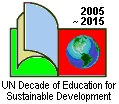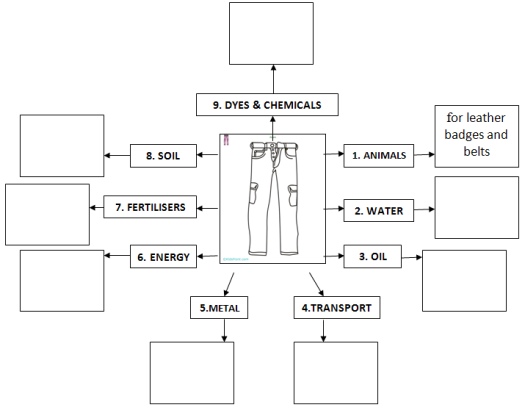Editorial
This text first appeared in the GI SIG IATEFL newsletterter.

Keeping Up With Fashion: Can Blue Jeans Be Green?
Aleksandra Zaparucha, Poland, and James Hindson, UK
Aleksandra Zaparucha is a freelance Geography and English teacher, EFL/CLIL teacher trainer, author and translator based in Toruń, Poland. E-mail: ola.zaparucha@gmail.com
James Hindson is a Geography teacher, specialist on Education for Sustainable Development and director of Sense&Sustainability, based in Shrewsbury, UK. E-mail: senseandsustainability@gmail.com
Menu
Warm-up
Fashion project
How to be a better consumer
Follow-up - extension
Show your class a photo of a few teenagers wearing jeans and T-shirts. Elicit the description of the clothes (blue jeans, cotton T-shirts, colours, patterns, etc). Ask the students to make a list of all the different materials that goes into producing a pair of jeans. They will come up with some suggestions, such as cotton, metal, chemicals, etc. Collect their ideas on the board and ask for any other remaining resources. Quite possible they will not think of the resources such as energy, labour and/or water.
The clothes I wear
Distribute handouts which deal with the resources indispensable for producing a pair of jeans. The students first check which resources they have not thought about. Later, they read the descriptions and match them with the resources. Variation: you can decide to actually cut out the boxes with the text and ask the students to manoeuvre them in the diagram and, once decided, glue them in appropriate places. As a follow up, collect all the students’ comments and reflections on the number and type of resources used for producing a pair of jeans.
HO 1. What goes into clothes?
Read the text and complete the graph.

| A. This is the main ingredient for all synthetic fibres such as nylon and polyester, as well as for the plastic used for things like buttons. And we are running out of it. |
D. If your clothes are from natural fibres then are made from something that grows on it. This is often done over-extensively. |
G. Lots of clothes have some animal products in them such as badges and belts. Processing animal skins for leather is very polluting. |
| B. If your clothes are made of natural fibres then a lot of them are used. In some countries they damage the soil and water because farmers do not use them properly. |
E. If you have clothes made from natural fibres (cotton, linen) then a lot of it is used to grow the plants. All clothes are dyed – and this process uses a lot of it as well. |
H. Lots of them are used in manufacturing of most clothing – mostly in the dying process. |
| C. The ingredients for clothes often come from around 10 different countries. Jeans are rarely made in one place. |
F. Some clothes have a little bit of it in them - for some of the buttons or fastening studs or zips. Mining and processing creates a lot of waste. |
I. It is used at nearly every stage of making anything – clothes included, and in the shops selling your clothes. Lots of carbon dioxide is produced. |
Answers: A3, B7, C4, D8, E2, F5, G1, H9, I6
Then tell about the questionnaire on the number of T-shirts each of the students has at home. Distribute the copies of the questionnaire. Allocate enough time for completing the survey.
HO2. Are my clothes a problem then?
Fashion Project. You are obviously using a lot of the planet’s resources and thus damaging it when you get dressed each day. One of the problems is fashion. Complete this fashion questionnaire.
| Individual Fashion Questionnaire: Me and my T-shirts |
| 1 |
When was the last time you bought an item of clothing to wear? 1-2-3-4-5-6 weeks/months ago |
| 2 |
How many T-shirts/shirts/tops do you own? (estimate) 1-5 6-10 11-15 16-20 20+ |
| 3 |
How many of the T-shirts/shirts/tops do you wear regularly? 1-5 6-10 11-15 16-20 20+ |
| 4 |
How long do you keep a T-shirt/shirt/top before you stop wearing it? 2-4-6-8-10-12-18-24 months |
| 5 |
What do you do with your T-shirts when you have finished with them?
a. throw away, b. give away, c. give to charity, d. sell, e. use the fabric for cleaning, f. other (what?)
|
| 6 |
Be honest – do you think you have too many T-shirts/shirts/tops?
Yes, for sure! Rather yes... don’t know rather no Not at all!
|
| 7 |
Could you live with fewer T-shirts/shirts/tops without it being a problem ?
Yes, for sure! Rather yes... don’t know rather no Not at all!
|
| 8 |
Haw many fewer T-shirts/shirts/tops could you live without? half as many a quarter 10% less |
Compare your answers with those of other students. Are they similar? Why? Why not? Any conclusions?
Once completed, ask the students to cut their questionnaire into slips of paper – each with the answers to only one question. Divide the class into 8 groups of 3-4 students depending on the size of the class. Each group collects the answers to only one question, sums up the results and presents the findings to the class. Discuss the results with the students.
Summing up, producing clothes is very resurce-consuming. Can we be better citiens? How about buying less? Give the students another handout with the suggestions how they can be better citizens by consumin less.
HO3. How to be a better consumer?
You have to wear clothes and you have to buy them from the shops that exist – but do you? Look at the options in the boxes below. Do you do any of these things? Which you could stat doing to help the planet?

Use the following prompts:

Once the students have decided ask them to use the prompts to express their ideas.
Fair trade clothes
As an extension to the lesson ask the students to google the websites for teenagers who are aware of their everyday choices, including fashion. This can develop into a smaller-scale project and/or a whole-school campaign.
Google Green Girls Global and/or Green Guys Global to read about youngsters who have become aware of the influence their everyday choices exert on the planet http://greengirlsglobal.com/blog/water-blue-jeans. You can prepare a poster advertising the website among you schoolmates and/or write an article for a school magazine/newsletter.

Please check the Creative Methodology for the Classroom course at Pilgrims website.
Please check the CLIL for Secondary Teachers course at Pilgrims website.
Please check the Methodology & Language for Secondary Teachers course at Pilgrims website.
Please check the Teaching Advanced Students course at Pilgrims website.


|